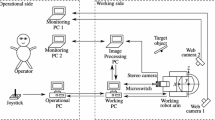Abstract
This paper considers the development of a teleoperation system for a mobile robot arm with visual servo mechanism. The robot to be operated mainly consists of a mobile robot and a robot arm with USB camera. The robot is teleoperated according to the control command which is generated by combining the manual operation with the autonomous control via the vision system based on the USB camera images. In this paper, a control method of determining the turning radius of the mobile robot is proposed based on the angle information of image corresponding to the error of a target position from the reference one. To evaluate the proposed teleoperation system, experiments of pressing a button were conducted by using an actual robot. It was verified from the experimental results that sufficiently high success rate of teleoperation could be obtained by the proposed method.









Similar content being viewed by others
Explore related subjects
Discover the latest articles and news from researchers in related subjects, suggested using machine learning.References
Sheridan T (1995) Teleoperation, telerobotics and telepresence: a progress report. Control Eng Pract 3(2):204–214
Choi H, Jung S (2009) Neural network-based Smith predictor design for the time-delay in a tele-operated control system. Artif Life Robot 14(4):578–583
Goto S (2010) Teleoperation system of industrial articulated robot arms by using forcefree control. In: Jimenez A, Hadithi B (eds) Robot manipulators trends and development. Intech, London, pp 321–334
Kushida D, Nakamura M, Goto S, Kyura N (2001) Human direct teaching of industrial articulated robot arms based on force-free control. Artif Life Robot 5(1):26–32
Goto S, Yano O, Matsuda Y, Sugi T, Egashira N (2017) Development of hands-free remote operation system for a mobile robot using EOG and EMG. Electron Commun Jpn 100(10):38–47
Hutchinson S, Hager GD, Corke PI (1996) A tutorial on visual servo control. IEEE Trans Robot Autom 12(5):651–670
Han S, Bae J, Lee M (2000) Intelligent control of a robot manipulator by visual feedback. Artif Life Robot 4(3):156–161
Huang Y, Zhang X, Fang Y (2014) Vision-based minimum-time planning of mobile robots with kinematic and visibility constraints. IFAC Proc Vol 47(3):11878–11883
Wang Y, Zhang G, Lang H, Zuo B, Silva C (2014) A modified image-based visual servo controller with hybrid camera configuration for robust robotic grasping. Robot Auton Syst 62(10):1398–1407
Chang W (2018) Robotic assembly of smartphone back shells with eye-in-hand visual servoing. Robot Comput Integr Manuf 50:102–113
Pallegedara A, Matsuda Y, Matsumoto T, Tsukamoto K, Egashira N, Goto S (2012) Teleoperation of robot arms using force-free control and template matching. Int J Innov Comput Inf Control 8(10A):6869–6884
Pallegedara A, Matsuda Y, Egashira N, Sugi T, Goto S (2013) Experimental evaluation of teleoperation system with force-free control and visual servo control by human operator perception. Artif Life Robot 17(3–4):388–394
Matsuda Y, Tsukamoto K, Matsumoto T, Goto S, Sugi T, Egashira N (2014) Remote operation system of robot arm with visual servo mechanism by target selection. Int J Innov Comput Inf Control 10(4):1381–1390
Matsuda Y, Sugi T, Goto S, Egashira N (2016) Teleoperation of robot arm with position measurement via angle-pixel characteristic and visual supporting function. Artif Life Robot 21(4):478–485
Matsuda Y, Sugi T, Goto S, Egashira N (2017) Teleoperation system for a mobile robot with visual servo mechanism based on automatic template generation. Artif Life Robot 22(4):490–496
Bradski G, Kaehler A (2008) Learning OpenCV: computer vision with the Open CV library. O’Reilly Media, Sebastopol
Author information
Authors and Affiliations
Corresponding author
About this article
Cite this article
Matsuda, Y., Tagami, N., Sugi, T. et al. Teleoperation system for a mobile robot arm with visual servomechanism based on turning radius determination using angle information of image. Artif Life Robotics 24, 106–113 (2019). https://doi.org/10.1007/s10015-018-0455-9
Received:
Accepted:
Published:
Issue Date:
DOI: https://doi.org/10.1007/s10015-018-0455-9




